人教版(2019)必修第一册Unit2 Travelling around Reading and Thinking 教学设计及说课课件 (共26张PPT)
文档属性
| 名称 | 人教版(2019)必修第一册Unit2 Travelling around Reading and Thinking 教学设计及说课课件 (共26张PPT) | 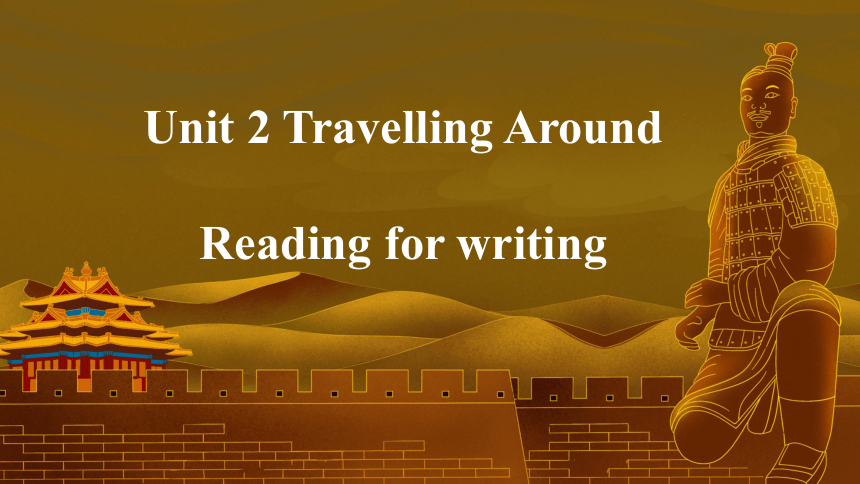 | |
| 格式 | pptx | ||
| 文件大小 | 49.0MB | ||
| 资源类型 | 教案 | ||
| 版本资源 | 人教版(2019) | ||
| 科目 | 英语 | ||
| 更新时间 | 2023-12-24 20:38:36 | ||
图片预览

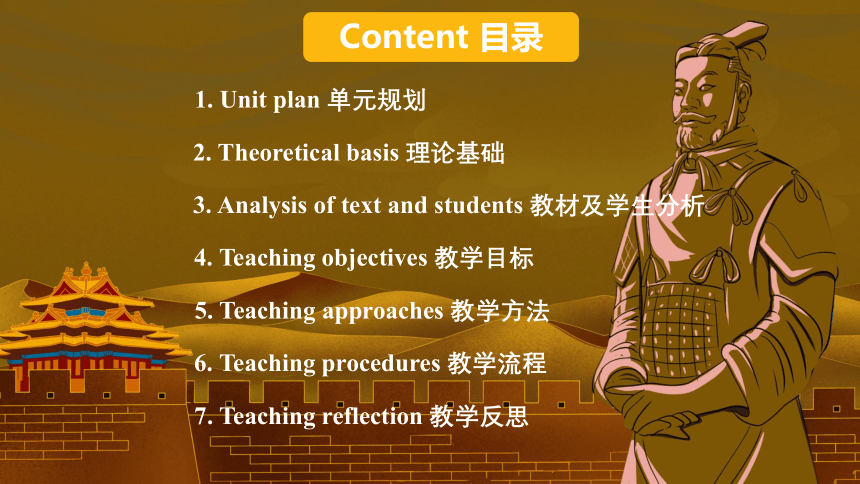
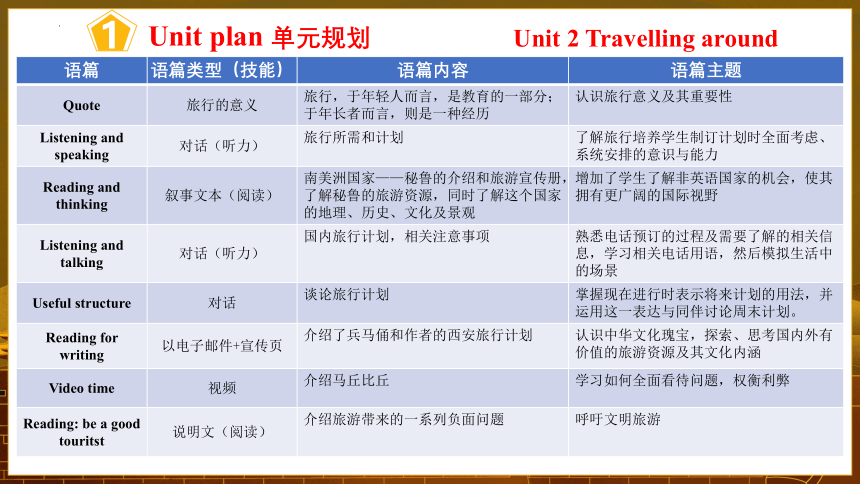

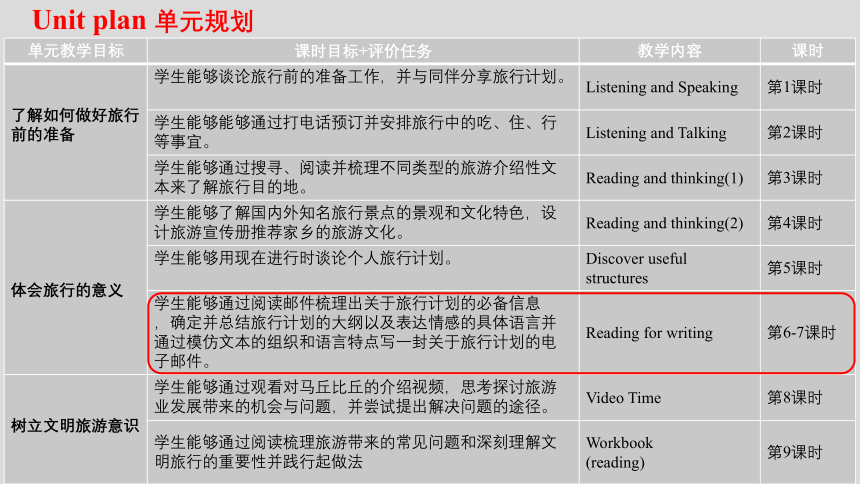
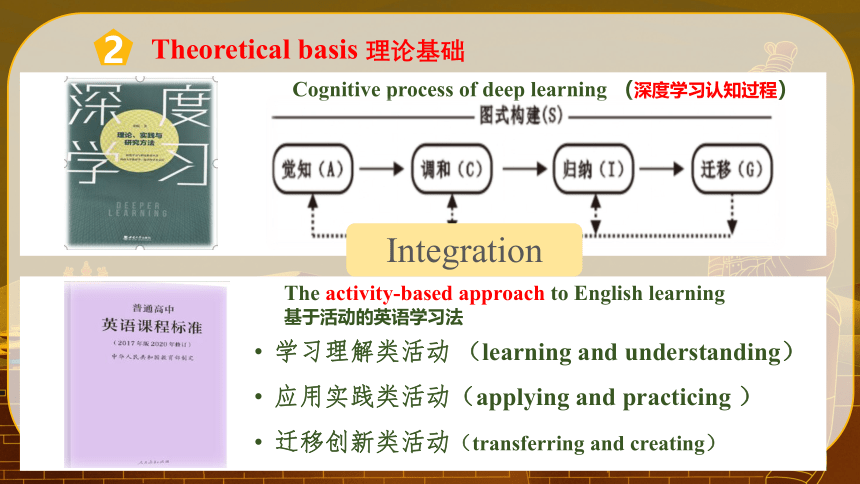
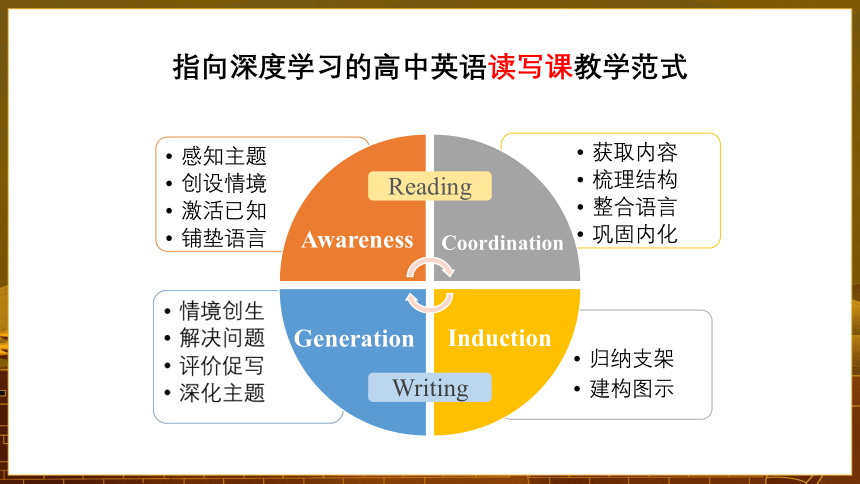
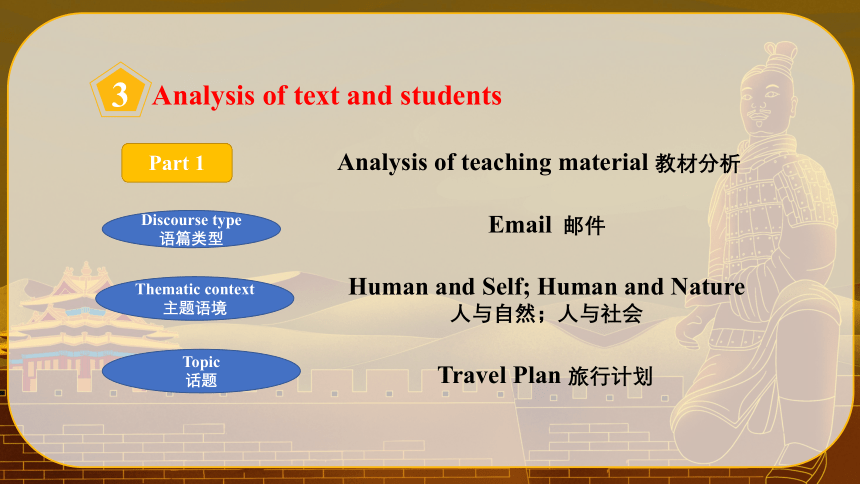
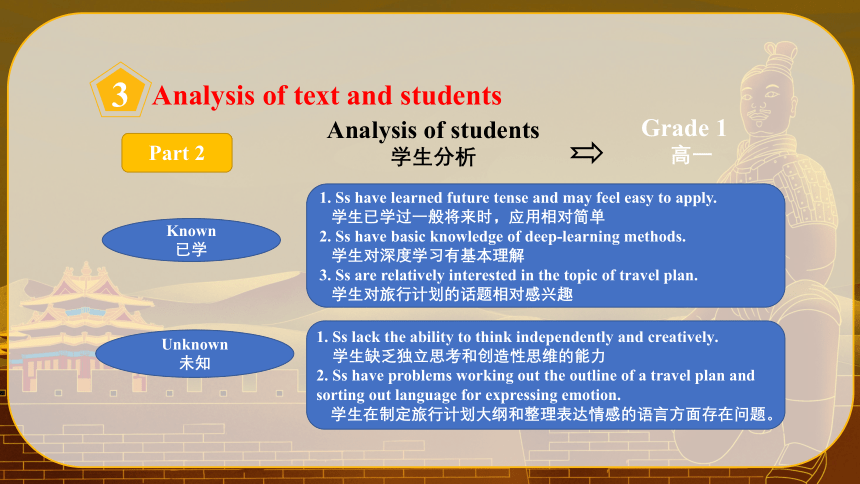
文档简介
(共26张PPT)
Unit 2 Travelling Around
Reading for writing
Content 目录
3. Analysis of text and students 教材及学生分析
4. Teaching objectives 教学目标
5. Teaching approaches 教学方法
6. Teaching procedures 教学流程
7. Teaching reflection 教学反思
1. Unit plan 单元规划
2. Theoretical basis 理论基础
1
Unit plan 单元规划
Unit 2 Travelling around
语篇 语篇类型(技能) 语篇内容 语篇主题
Quote 旅行的意义 旅行,于年轻人而言,是教育的一部分;于年长者而言,则是一种经历 认识旅行意义及其重要性
Listening and speaking 对话(听力) 旅行所需和计划 了解旅行培养学生制订计划时全面考虑、系统安排的意识与能力
Reading and thinking 叙事文本(阅读) 南美洲国家——秘鲁的介绍和旅游宣传册,了解秘鲁的旅游资源,同时了解这个国家的地理、历史、文化及景观 增加了学生了解非英语国家的机会,使其拥有更广阔的国际视野
Listening and talking 对话(听力) 国内旅行计划,相关注意事项 熟悉电话预订的过程及需要了解的相关信息,学习相关电话用语,然后模拟生活中的场景
Useful structure 对话 谈论旅行计划 掌握现在进行时表示将来计划的用法,并运用这一表达与同伴讨论周末计划。
Reading for writing 以电子邮件+宣传页 介绍了兵马俑和作者的西安旅行计划 认识中华文化瑰宝,探索、思考国内外有价值的旅游资源及其文化内涵
Video time 视频 介绍马丘比丘 学习如何全面看待问题,权衡利弊
Reading: be a good touritst 说明文(阅读) 介绍旅游带来的一系列负面问题 呼吁文明旅游
人与自然:旅行
Reading and thinking:
Brochure design
Listening and speaking:
Preparation for travel
Reading for writing:
Travel plan
Listening and talking:
Making reservations
单元大观念:学生通过制定行前计划,提高规划能力,通过了解国内外的著名景点和文化特色,拓展国际视野,最后了解旅游业发展的利弊,树立文明游客意识。
旅行后的感悟
旅行中的收获
旅行前的准备
Pros & cons of tourism
(Workbook-reading)
Tourism of Machu Picchu
(Video time)
Reading and thinking:
Information for destination
Discover Useful Structures:
Travel plan
Unit project: 设计一条旅行路线(包括选择目的地,衣食住行,文明旅行意识)
单元教学目标 课时目标+评价任务 教学内容 课时
了解如何做好旅行 前的准备 学生能够谈论旅行前的准备工作,并与同伴分享旅行计划。 Listening and Speaking 第1课时
学生能够能够通过打电话预订并安排旅行中的吃、住、行等事宜。 Listening and Talking 第2课时
学生能够通过搜寻、阅读并梳理不同类型的旅游介绍性文本来了解旅行目的地。 Reading and thinking(1) 第3课时
体会旅行的意义 学生能够了解国内外知名旅行景点的景观和文化特色,设计旅游宣传册推荐家乡的旅游文化。 Reading and thinking(2) 第4课时
学生能够用现在进行时谈论个人旅行计划。 Discover useful structures 第5课时
学生能够通过阅读邮件梳理出关于旅行计划的必备信息 ,确定并总结旅行计划的大纲以及表达情感的具体语言并 通过模仿文本的组织和语言特点写一封关于旅行计划的电子邮件。 Reading for writing 第6-7课时
树立文明旅游意识 学生能够通过观看对马丘比丘的介绍视频,思考探讨旅游业发展带来的机会与问题,并尝试提出解决问题的途径。 Video Time 第8课时
学生能够通过阅读梳理旅游带来的常见问题和深刻理解文明旅行的重要性并践行起做法 Workbook (reading) 第9课时
Unit plan 单元规划
2
Theoretical basis
Cognitive process of deep learning (深度学习认知过程)
Theoretical basis 理论基础
The activity-based approach to English learning
基于活动的英语学习法
学习理解类活动 (learning and understanding)
应用实践类活动(applying and practicing )
迁移创新类活动(transferring and creating)
Integration
2
情境创生
解决问题
评价促写
深化主题
Awareness
Coordination
Generation
Induction
Reading
Writing
指向深度学习的高中英语读写课教学范式
3
Analysis of text and students
Discourse type
语篇类型
Thematic context
主题语境
Topic
话题
Email 邮件
Human and Self; Human and Nature
人与自然;人与社会
Travel Plan 旅行计划
Part 1
Analysis of teaching material 教材分析
3
Analysis of text and students
Known
已学
Unknown
未知
Part 2
Analysis of students 学生分析
Grade 1
高一
1. Ss have learned future tense and may feel easy to apply.
学生已学过一般将来时,应用相对简单
2. Ss have basic knowledge of deep-learning methods.
学生对深度学习有基本理解
3. Ss are relatively interested in the topic of travel plan.
学生对旅行计划的话题相对感兴趣
1. Ss lack the ability to think independently and creatively.
学生缺乏独立思考和创造性思维的能力
2. Ss have problems working out the outline of a travel plan and sorting out language for expressing emotion.
学生在制定旅行计划大纲和整理表达情感的语言方面存在问题。
用户可以在投影仪或者计算机上可以将演
示文稿打印出来制应用到更广泛的领域中
用户可以在投影仪或者计算机上可以将演
示文稿打印出来制应用到更广泛的领域中
用户可以在投影仪或者计算机上可以将演
示文稿打印出来制应用到更广泛的领域中
用户可以在投影仪或者计算机上可以将演
示文稿打印出来制应用到更广泛的领域中
1. To sort out information about a travel plan by reading the email.
通过阅读邮件梳理出关于旅行计划的必备信息
2. To identify and summarize the outline of a travel plan and the specific language for expressing emotion.
确定并总结旅行计划的大纲以及表达情感的具体语言。
3. To write an email talking about their travel plan by imitating its organization and language feature.
通过模仿文本的组织和语言特点,写一封关于旅行计划的电子邮件。
4
Teaching objectives 教学目标
Flipped Teaching Method
翻转教学法
Communicative Teaching Method
交际法
5
Teaching approaches 教学方法
Before the class 课前
During the class 课中
Teachers
教师
Students
学生
Text
文本
Information
信息
Inspiration
启示
6
Teaching procedures
教学过程
Stage 1: Warming-up 引入(准备)
Step 1: Pictures about Xi’an 西安图片
Stage 2: Before-reading 读前活动
Step 1: Pictures about Terracotta Army 兵马桶
Step 2: Prediction on what to learn 预测所学
Stage 3: While-reading 读中活动
Step 1: Understanding of the brochure 了解手册
Step 2: What aspects included in a travel plan 从哪些方面写旅行计划
Step 3: Analysis of the organization 分析文本结构
Step 4: Summary of expressions showing emotions 情感表达总结
Stage 4: Post-reading (writing) 读后活动(写作)
Step 1: Reviewing on sample writing 样本写作回顾
Step 2: Drafting your own travel plan and revising 起草旅行计划并修改
Stage 5: Assignment 作业
For foreign visitors, which city in China may attract them the most
(中国哪个城市最吸引外国游客?)
What do you think is special about Xi ’an
(西安有何特别之处?)
Purpose of design: to lead the topic; activate students’ prior knowledge.
设计意图:引出话题;激活学生关于话题的先验知识。
Terracotta Army 兵马俑
I am amazed by its size. I can’t
believe there are more than 8,000
statues in the tomb.
I am amazed by its long history.
The long history of the Terracotta Army
amazes me the most.
What amazes you the most
兵马俑的哪些信息让你惊叹?
Purpose of design: to initially perceive the language expressing emotions.
设计意图:初步感知表达情感的语言。
Read Richard’s email to his friend and figure out what aspects are mentioned in the travel plan.(读邮件并梳理旅行计划的主要方面)
Purpose of design: to sort out the main aspects of a travel plan.
设计意图:梳理旅行计划的主要方面(目标一达成)。
Read Richard’s email again and summarize the email in the table.
Purpose of design: to analyze the structure of the email.
设计意图:分析旅行计划邮件的结构(目标二部分达成)。
Read Richard’s email and underline the words and phrases to express emotion in the email. (读邮件并划出表达情绪的词和短语)
Purpose of design: to accumulate language expressing emotion.
设计意图:积累表达情感的语言(目标二达成)。
Purpose: to summarize how to write an email about travel plan.
设计意图:从写什么、如何写、用什么写来总结所学。
Write an email to Richard to introduce your travel plan.
(写邮件来介绍自己的旅行计划)
Purpose: to apply what they’ve learned into practice, namely, what aspects to cover, how to organize the email and how to express emotion.
设计意图:将所学知识应用到实践中,即涵盖哪些方面,如何组织该邮件以及如何表达情感。
Self-evaluation and peer evaluation (自我评价和同伴评价)
Purpose of design: to improve their writing and learn from others.
设计意图:根据要求改进自己的作品并通过同伴互评向他人学习(目标三达成)。
Plan A:
Polish the email based on self-evaluation and peer evaluation
Assignment 作业
Plan B:
Draw mind maps about what to write, how to organize an email about travel plan and how to express emotion.
Plan C:
Translate the text and recite it.
Purpose: to design homework in layers to stimulate students’ interest and enable those of different levels to gain something from their study.
设计意图:分层设计作业,激发学生兴趣,使不同层次的学生都学有所获。
Reflection 反思
Thanks!
谢谢!
Unit 2 Travelling Around
Reading for writing
Content 目录
3. Analysis of text and students 教材及学生分析
4. Teaching objectives 教学目标
5. Teaching approaches 教学方法
6. Teaching procedures 教学流程
7. Teaching reflection 教学反思
1. Unit plan 单元规划
2. Theoretical basis 理论基础
1
Unit plan 单元规划
Unit 2 Travelling around
语篇 语篇类型(技能) 语篇内容 语篇主题
Quote 旅行的意义 旅行,于年轻人而言,是教育的一部分;于年长者而言,则是一种经历 认识旅行意义及其重要性
Listening and speaking 对话(听力) 旅行所需和计划 了解旅行培养学生制订计划时全面考虑、系统安排的意识与能力
Reading and thinking 叙事文本(阅读) 南美洲国家——秘鲁的介绍和旅游宣传册,了解秘鲁的旅游资源,同时了解这个国家的地理、历史、文化及景观 增加了学生了解非英语国家的机会,使其拥有更广阔的国际视野
Listening and talking 对话(听力) 国内旅行计划,相关注意事项 熟悉电话预订的过程及需要了解的相关信息,学习相关电话用语,然后模拟生活中的场景
Useful structure 对话 谈论旅行计划 掌握现在进行时表示将来计划的用法,并运用这一表达与同伴讨论周末计划。
Reading for writing 以电子邮件+宣传页 介绍了兵马俑和作者的西安旅行计划 认识中华文化瑰宝,探索、思考国内外有价值的旅游资源及其文化内涵
Video time 视频 介绍马丘比丘 学习如何全面看待问题,权衡利弊
Reading: be a good touritst 说明文(阅读) 介绍旅游带来的一系列负面问题 呼吁文明旅游
人与自然:旅行
Reading and thinking:
Brochure design
Listening and speaking:
Preparation for travel
Reading for writing:
Travel plan
Listening and talking:
Making reservations
单元大观念:学生通过制定行前计划,提高规划能力,通过了解国内外的著名景点和文化特色,拓展国际视野,最后了解旅游业发展的利弊,树立文明游客意识。
旅行后的感悟
旅行中的收获
旅行前的准备
Pros & cons of tourism
(Workbook-reading)
Tourism of Machu Picchu
(Video time)
Reading and thinking:
Information for destination
Discover Useful Structures:
Travel plan
Unit project: 设计一条旅行路线(包括选择目的地,衣食住行,文明旅行意识)
单元教学目标 课时目标+评价任务 教学内容 课时
了解如何做好旅行 前的准备 学生能够谈论旅行前的准备工作,并与同伴分享旅行计划。 Listening and Speaking 第1课时
学生能够能够通过打电话预订并安排旅行中的吃、住、行等事宜。 Listening and Talking 第2课时
学生能够通过搜寻、阅读并梳理不同类型的旅游介绍性文本来了解旅行目的地。 Reading and thinking(1) 第3课时
体会旅行的意义 学生能够了解国内外知名旅行景点的景观和文化特色,设计旅游宣传册推荐家乡的旅游文化。 Reading and thinking(2) 第4课时
学生能够用现在进行时谈论个人旅行计划。 Discover useful structures 第5课时
学生能够通过阅读邮件梳理出关于旅行计划的必备信息 ,确定并总结旅行计划的大纲以及表达情感的具体语言并 通过模仿文本的组织和语言特点写一封关于旅行计划的电子邮件。 Reading for writing 第6-7课时
树立文明旅游意识 学生能够通过观看对马丘比丘的介绍视频,思考探讨旅游业发展带来的机会与问题,并尝试提出解决问题的途径。 Video Time 第8课时
学生能够通过阅读梳理旅游带来的常见问题和深刻理解文明旅行的重要性并践行起做法 Workbook (reading) 第9课时
Unit plan 单元规划
2
Theoretical basis
Cognitive process of deep learning (深度学习认知过程)
Theoretical basis 理论基础
The activity-based approach to English learning
基于活动的英语学习法
学习理解类活动 (learning and understanding)
应用实践类活动(applying and practicing )
迁移创新类活动(transferring and creating)
Integration
2
情境创生
解决问题
评价促写
深化主题
Awareness
Coordination
Generation
Induction
Reading
Writing
指向深度学习的高中英语读写课教学范式
3
Analysis of text and students
Discourse type
语篇类型
Thematic context
主题语境
Topic
话题
Email 邮件
Human and Self; Human and Nature
人与自然;人与社会
Travel Plan 旅行计划
Part 1
Analysis of teaching material 教材分析
3
Analysis of text and students
Known
已学
Unknown
未知
Part 2
Analysis of students 学生分析
Grade 1
高一
1. Ss have learned future tense and may feel easy to apply.
学生已学过一般将来时,应用相对简单
2. Ss have basic knowledge of deep-learning methods.
学生对深度学习有基本理解
3. Ss are relatively interested in the topic of travel plan.
学生对旅行计划的话题相对感兴趣
1. Ss lack the ability to think independently and creatively.
学生缺乏独立思考和创造性思维的能力
2. Ss have problems working out the outline of a travel plan and sorting out language for expressing emotion.
学生在制定旅行计划大纲和整理表达情感的语言方面存在问题。
用户可以在投影仪或者计算机上可以将演
示文稿打印出来制应用到更广泛的领域中
用户可以在投影仪或者计算机上可以将演
示文稿打印出来制应用到更广泛的领域中
用户可以在投影仪或者计算机上可以将演
示文稿打印出来制应用到更广泛的领域中
用户可以在投影仪或者计算机上可以将演
示文稿打印出来制应用到更广泛的领域中
1. To sort out information about a travel plan by reading the email.
通过阅读邮件梳理出关于旅行计划的必备信息
2. To identify and summarize the outline of a travel plan and the specific language for expressing emotion.
确定并总结旅行计划的大纲以及表达情感的具体语言。
3. To write an email talking about their travel plan by imitating its organization and language feature.
通过模仿文本的组织和语言特点,写一封关于旅行计划的电子邮件。
4
Teaching objectives 教学目标
Flipped Teaching Method
翻转教学法
Communicative Teaching Method
交际法
5
Teaching approaches 教学方法
Before the class 课前
During the class 课中
Teachers
教师
Students
学生
Text
文本
Information
信息
Inspiration
启示
6
Teaching procedures
教学过程
Stage 1: Warming-up 引入(准备)
Step 1: Pictures about Xi’an 西安图片
Stage 2: Before-reading 读前活动
Step 1: Pictures about Terracotta Army 兵马桶
Step 2: Prediction on what to learn 预测所学
Stage 3: While-reading 读中活动
Step 1: Understanding of the brochure 了解手册
Step 2: What aspects included in a travel plan 从哪些方面写旅行计划
Step 3: Analysis of the organization 分析文本结构
Step 4: Summary of expressions showing emotions 情感表达总结
Stage 4: Post-reading (writing) 读后活动(写作)
Step 1: Reviewing on sample writing 样本写作回顾
Step 2: Drafting your own travel plan and revising 起草旅行计划并修改
Stage 5: Assignment 作业
For foreign visitors, which city in China may attract them the most
(中国哪个城市最吸引外国游客?)
What do you think is special about Xi ’an
(西安有何特别之处?)
Purpose of design: to lead the topic; activate students’ prior knowledge.
设计意图:引出话题;激活学生关于话题的先验知识。
Terracotta Army 兵马俑
I am amazed by its size. I can’t
believe there are more than 8,000
statues in the tomb.
I am amazed by its long history.
The long history of the Terracotta Army
amazes me the most.
What amazes you the most
兵马俑的哪些信息让你惊叹?
Purpose of design: to initially perceive the language expressing emotions.
设计意图:初步感知表达情感的语言。
Read Richard’s email to his friend and figure out what aspects are mentioned in the travel plan.(读邮件并梳理旅行计划的主要方面)
Purpose of design: to sort out the main aspects of a travel plan.
设计意图:梳理旅行计划的主要方面(目标一达成)。
Read Richard’s email again and summarize the email in the table.
Purpose of design: to analyze the structure of the email.
设计意图:分析旅行计划邮件的结构(目标二部分达成)。
Read Richard’s email and underline the words and phrases to express emotion in the email. (读邮件并划出表达情绪的词和短语)
Purpose of design: to accumulate language expressing emotion.
设计意图:积累表达情感的语言(目标二达成)。
Purpose: to summarize how to write an email about travel plan.
设计意图:从写什么、如何写、用什么写来总结所学。
Write an email to Richard to introduce your travel plan.
(写邮件来介绍自己的旅行计划)
Purpose: to apply what they’ve learned into practice, namely, what aspects to cover, how to organize the email and how to express emotion.
设计意图:将所学知识应用到实践中,即涵盖哪些方面,如何组织该邮件以及如何表达情感。
Self-evaluation and peer evaluation (自我评价和同伴评价)
Purpose of design: to improve their writing and learn from others.
设计意图:根据要求改进自己的作品并通过同伴互评向他人学习(目标三达成)。
Plan A:
Polish the email based on self-evaluation and peer evaluation
Assignment 作业
Plan B:
Draw mind maps about what to write, how to organize an email about travel plan and how to express emotion.
Plan C:
Translate the text and recite it.
Purpose: to design homework in layers to stimulate students’ interest and enable those of different levels to gain something from their study.
设计意图:分层设计作业,激发学生兴趣,使不同层次的学生都学有所获。
Reflection 反思
Thanks!
谢谢!
